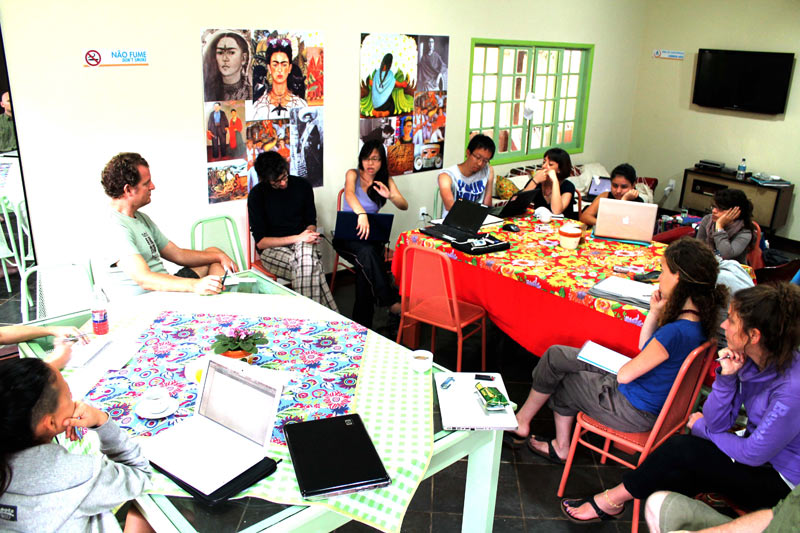This is the student blog documenting the master’s field trip to Brazil to continue work on the Rio Floods Petropolis Sports-for-Change project in Brazil, in collaboration with Architecture for Humanity. Click here for the entire series.
————————————
Nogueira, Itaipava – Sunday February 12th 9am: Sunshine and clear skies…..
Nathaniel Corum, Architecture for Humanity’s head of educational outreach, pulls us together as a complete team to discuss what lies ahead. It’s our 6th day in Brazil, having spent the previous 3 weeks in Barcelona designing proposals for a sports and community facility in collaboration with Architecture for Humanity. ‘Sports for Change’ is the project’s working title.
He opens with a project recap and continues to outline the focus of the day. We will be developing our proposals with the assistance of fresh information from the preceding days and assembling a concise presentation for tomorrow’s meeting with the project coordinator, architect and engineer responsible for the site master plan, which our design will be a part of.
 The morning’s meeting to discuss the day ahead
The morning’s meeting to discuss the day ahead
A group discussion shortly begins, responding to our first visit to the project site in Petropolis the previous day. It’s soon evident our earlier design concepts have now expanded, altered and even been dramatically redirected. One often finds they will have a preconception of a place and its surroundings before first visiting and experiencing it. For many of us this case is no different, and questions are now raised which need to be reconsidered.
“How can we most effectively interconnect the proposal with the natural surrounding?”
“Can we provide a multi-use facility accessible to the entire community?”
Our thoughts thrive as fresh ideas are introduced and we conclude the briefing with a sense of renewed energy, enthusiasm and passion.
Fragmenting into smaller project teams, 2-4 per group, we spread ourselves throughout the hostel to settle into a quiet and peaceful space. Some prefer the fresh air and sunshine while others stay indoors and spread their work over large tables to work most efficiently.
I find this approach to design, focusing on group work and collaboration, to be a delicate and often prolonged process, with all new ideas carefully considered and passionately debated at length. In my group, we wrestle with the challenges of blending the proposal into the site’s landscape with minimal disturbance to its existing contours and incorporating locally sourced materials, including bamboo and timber into the building’s structure.
The project site and local community are foreign to all of us. As such we often feel like outsiders in the design process and as our proposal continues its development we find providing a scheme which respects both the community and surrounding area presents us with diverse challenges. Local culture, community demographic, accessibility and the area’s natural features are always present in our thinking.

Tommaso Sacconi and his thoughts
The hours pass and our proposals begin to organically take shape, with a short break for lunch providing an ideal moment to clear and recharge the mind. Our work continues late into the evening, with a contrasting range of building forms and design concepts evolving. Some choose the approach of ‘hiding’ and incorporating the building within the site’s landscaping while others have it raised to maximise ventilation and views of the surrounding mountains.
Reflecting on my involvement in the Sports for Change project, I start to question how I can incorporate the concepts and processes I have learned into my upcoming internship in Mongolia. I will be spending a three-month period in Ulaanbaatar, Mongolia’s capital with UN Habitat’s Community-Led Ger Area Upgrading program. A different continent, and a vastly contrasting climate and culture awaits. Thus far my time in Brazil and the collaboration with Architecture for Humanity has been an invaluable experience, broadening my tools for ethical participatory design. Most importantly I’ve found we must approach every project sensitively, regardless of the place in which it may be. It can be a dangerous practice to enter with preconceived ideas and strong opinions before immersing yourself in the local community, culture and area.
We all end the day with a great sense of accomplishment and pride in the work we have developed. Tomorrow morning’s presentations and discussions awaits…




It seems Andrew has been completely enjoyed the trip! and the blog is enlightening, entertaining, educational, engaging, energiging and Excellent!
Looking forward to hear from Mongolia!
Sonam